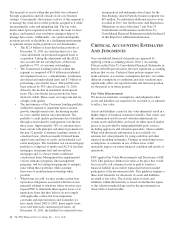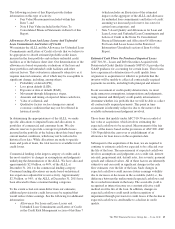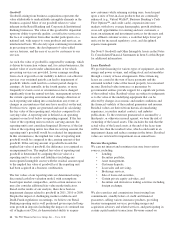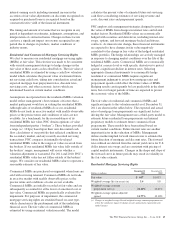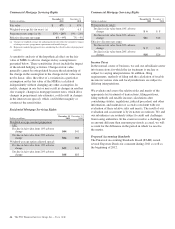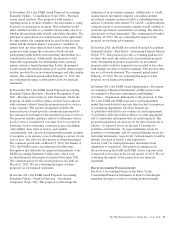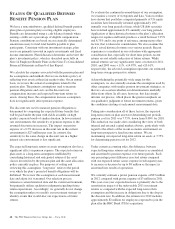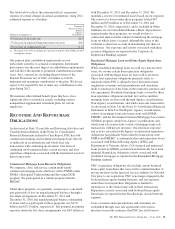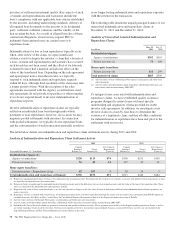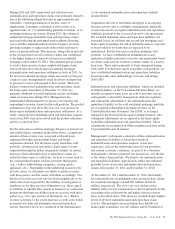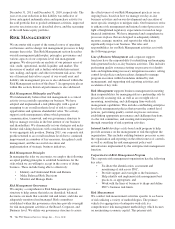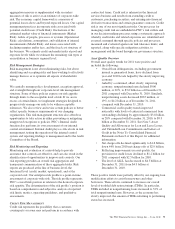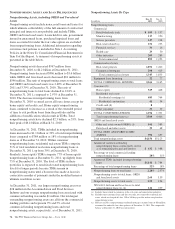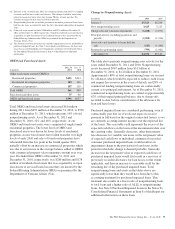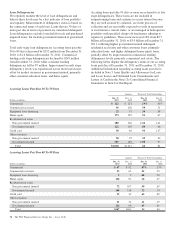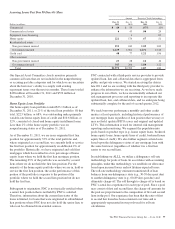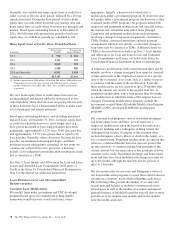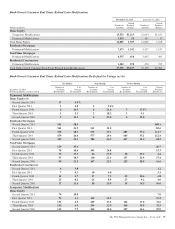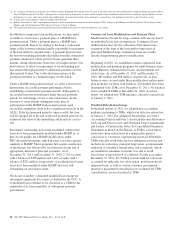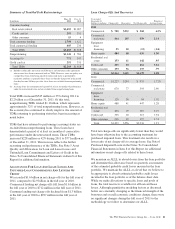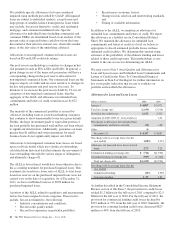PNC Bank 2011 Annual Report Download - page 81
Download and view the complete annual report
Please find page 81 of the 2011 PNC Bank annual report below. You can navigate through the pages in the report by either clicking on the pages listed below, or by using the keyword search tool below to find specific information within the annual report.December 31, 2011 and December 31, 2010, respectively. The
year-over-year reduction in this liability was reflective of
lower anticipated indemnification and repurchase activity for
the sold portfolio due to pooled settlement activities, improved
investor rescission rates as described above, and the seasoning
of the sold home equity portfolio.
R
ISK
M
ANAGEMENT
We encounter risk as part of the normal course of operating
our business and we design risk management processes to help
manage these risks. This Risk Management section describes
our risk management philosophy, principles, governance and
various aspects of our corporate-level risk management
program. We also provide an analysis of our primary areas of
risk: credit, operational, model, liquidity, and market. The
discussion of market risk is further subdivided into interest
rate, trading, and equity and other investment risk areas. Our
use of financial derivatives as part of our overall asset and
liability risk management process is also addressed within the
Risk Management section of this Item 7. In appropriate places
within this section, historical performance is also addressed.
Risk Management Philosophy and Profile
We fundamentally believe that risk management is a critical
activity in successfully operating our business. We have
adopted and implemented a risk philosophy with a goal of
managing to an overall moderate level of risk to capture
opportunities and optimize shareholder value. We actively
support a risk management culture which promotes
communication, teamwork, and our governance structure to
help us manage our risks in the best interest of our business
and shareholders. We dynamically set our strategies and make
distinct risk taking decisions with consideration for the impact
to our aggregate risk position. During 2011, our corporate risk
profile returned to an overall moderate level due to continued
improvement in a number of key measures, disciplined credit
management, and the successful execution and
implementation of strategic business initiatives.
Risk Management Principles
In managing the risks we encounter, we employ the following
accepted guiding principles to establish boundaries for the
risks which we are willing to accept in the course of doing
business. These include being able to effectively:
• Identify and Understand Risks and Returns
• Make Balanced Risk Decisions
• Monitor and Manage Risks
Risk Management Governance
We employ a comprehensive Risk Management governance
structure to help ensure that risks are identified; balanced
decisions are made that consider risk and return; and risks are
adequately monitored and managed. Risk committees
established within this governance structure provide oversight
for risk management activities at the Board, Corporate, and
Business level. We utilize our governance structure to assess
the effectiveness of our Risk Management practices on an
ongoing basis, based on how we manage our day-to-day
business activities and on our development and execution of
more specific strategies to mitigate risks. Our businesses strive
to enhance risk management and internal control processes in
light of heightened regulatory expectations focused on large
financial institutions. We have integrated and comprehensive
processes in place that are designed to adequately identify,
measure, manage, monitor, and report risks which may
significantly impact our business. The roles and
responsibilities for our Risk Management activities rest with
the following groups:
Line of Business Management and corporate support
functions have the responsibility for identifying and managing
risks generated in day-to-day business activities. This includes
performing quality assurance testing on processes to identify
risks and implementing necessary mitigation measures; setting
control level policies and procedures designed to manage
program execution within boundaries defined by risk
management; and supporting risk reporting activities and
escalation of key risks.
Risk Management supports business management in meeting
their responsibilities for managing risk in a partnership role by
proactively assessing risk, as well as an oversight role of
measuring, monitoring, and challenging firm-wide risk
management capabilities. This includes establishing enterprise
level risk management policies that govern the control level
policies, performing quality control on process outcomes,
establishing appropriate governance and challenge functions
via the risk committees, and creating risk transparency
through ownership of risk reporting activities.
Internal Audit develops a risk-based audit program to help
provide assurance on the management of risk throughout the
organization. This includes auditing business processes across
the organization and reporting on the effectiveness of controls,
as well as auditing the risk management policy and
infrastructure implemented by the enterprise risk management
function.
Corporate-Level Risk Management Program
The corporate risk management organization has the following
key roles:
• Facilitate the identification, assessment and
monitoring of risk across PNC,
• Provide support and oversight to the businesses,
• Help identify and implement risk management best
practices, as appropriate, and
• Work with the lines of business to shape and define
PNC’s business risk limits.
Risk Measurement
We conduct risk measurement activities specific to each area
of risk utilizing a variety of methodologies. The primary
vehicle for aggregation of enterprise-wide risk is a
comprehensive risk management methodology which focuses
on maximizing economic capital. This primary risk
72 The PNC Financial Services Group, Inc. – Form 10-K


